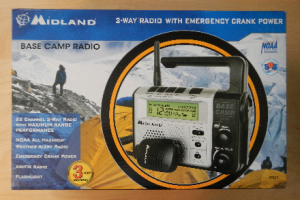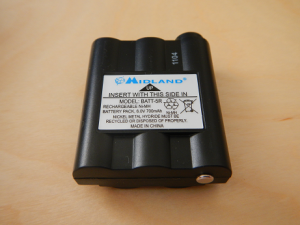I’ve written about some other radios, and have discussed various amateur, FRS/GMRS, and other two-way radios, but the Midland XT511 is one of the best options out there when it comes to very basic, general emergency communication equipment that requires no license or training.

The Midland XT511 is a full-featured, FRS/GMRS/NOAA/AM/FM radio with a variety of power options for emergency use.
Here is a quick run-down on the features packed into this compact package:
- Charge your cell phone or other USB-connected devices
- LED Flashlight
- AM and FM radio reception
- NOAA weather radio reception, including hazard alerts
- Transmit and receive FRS/GMRS, with privacy codes and other features available
- Scan FRS/GMRS traffic in your area
Not only does is have AM & FM reception, FRS & GMRS (two-way), it has a built-in weather radio. But that’s not the best part. It also uses four AA batteries and has a separate, built-in rechargeable battery pack, which can be charged by the included AC and DC charging cords. But we’re still not at the best part. Here is a big difference between this radio and many others: it has a hand crank that folds out from the side, which will allow you to
recharge the batteries with no other power source. In addition, you can use the USB port to charge other devices (e.g., your cell phone) by turning the crank. All of these features fit into a package that’s smaller than I thought it would be. This radio is quite flexible!

As you can see here, the XT511 can be powered with AA batteries, its internal rechargeable battery, a DC power supply, AC power supply, and the crank arm. This is a great set of options for an emergency radio.

You can see some of the many features available in the sticker that covers the display, fresh out of the box.
That’s a decent set of features in a handy, small package, and this radio should at least be on your “emergency” shelf. along with your spare batteries, lantern, extra food and water, first-aid kit, and other supplies.
I still recommend a set of FRS/GMRS radios as one of the most important emergency communications tools for everyone, but at the same time I think this radio is just as important. While your existing handheld radios should operate on AA batteries in addition to a rechargeable battery pack, and should also receive the NOAA weather (or “all-hazards”) channels and alerts, it’s unlikely that they can be recharged manually like this one. In addition, it has a built-in three-LED flashlight (which is relatively bright). Did I mention that the device has a lot of features?
It also has a handheld microphone/speaker, with a couple of interesting options. The plug is two-part. One part of the plug fits in the microphone jack,and one fits into the speaker jack. When it’s plugged in, as you probably expect, the built-in microphone and speaker on the front of the radio are disabled. But what if you still want to operate the hand-microphone quietly?

The convenient headphone jack in base of the handheld microphone (shown with the attached plug out of the jack) makes it easier to use and hear the radio in noisy or quiet environments.
The handset has another speaker jack, into which you can plug an earpiece. Good thinking on the part of the engineers. The features just keep coming!
So far, the radio is working fine for me. To echo one of my coworker’s comments, while some of the dials may seem a little bit loose, the radio still appears to be plenty sturdy and is holding up well. Most of the reviews I see on Amazon also seem to indicate similar experience.
As you can see on the box in the first picture, the Midland XT511 is called “Base Camp Radio,” and I think the description is a good one. While it’s not the first radio I’d put in my backpack, due to its size (even though it isn’t that heavy), it’s a great radio to have at home or wherever else you call your base camp, especially if you have an emergency where you lose grid power, even long-term.

